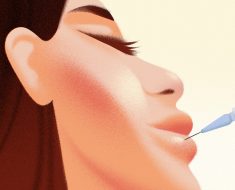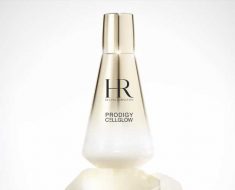I was 20 when I sprouted my first gray hair. I remember standing in my dimly lit college apartment bathroom when I noticed a long, silver strand sticking out against a sea of dark brown hair. In a panic (I know, I know there are worse things), I immediately called my mom. I could not believe that at 20 years old, I had a gray hair.
While this may seem dramatic, as a beauty writer I’m bombarded on a daily basis with products marketed to give or maintain a youthful look. I also come from a family that doesn’t really like to show — or tell — their age. Both my gorgeous grandmothers dyed their hair until they passed, slathered on face creams each day and night, and tried to appear as youthful as possible with the help of blush and a bold lip. My mother is no different. Since the day I turned 16, she’s instilled in me the importance of moisturizer to keep wrinkles away, eye cream to avoid getting crow’s-feet, and she constantly told me how much she absolutely despises gray hair.
Fighting It
Of course, my mother yelled, “pluck it out” after I told her. But then she shared that she also started going gray in her early 20s and that I was “going to be white as a ghost by 30.” After hanging up, I immediately yanked the wiry white hair out of my scalp using my trusty Tweezerman tweezers and called it day.
When men go gray, they’re 'silver foxes.' When women do, we're
considered old, washed up, and even undesirable.
Over the next few years, however, grays continued to pop up. I decided I'd had enough and was going to dye my hair blue-black, the deepest, richest shade I could find. And I did: Every four months, like clockwork, I would go to the salon on my block and get my dark brown hair transformed into raven-colored strands. My friends would ask why I was dyeing my already-dark hair, and I would lie. “Oh, I just want my hair to be super dark," I'd claim. "You know, like the Kardashians.”
About six months ago, money got tight. I had to cut out any luxuries and that included dyeing my hair. I thought, Well, I’ll just wear it up, so no one will notice the grays. My attempt to hide them failed. I was at dinner with one of my best friends and between bites of her juicy burger she blurted out, “Abe, since when do you have gray hairs?” I turned bright red and muttered, “No, I don’t. It's the weird restaurant lighting.”
I stopped mid-pluck and thought to myself, Why am I doing this? Why am I so ashamed?
In that moment, I thought about everything I'd spent over the last five years. All that time, money, and energy devoted to plucking, dyeing, and relying on root touch-up sprays and powders to disguise silver strands that no one — except for my mom and a few close family members — knew that I had.
After dinner, I rushed home and stared at my mixed-color roots in my Simple Human mirror under the five-times magnification, meticulously sifting through to find all the gray hairs I could. I started plucking. A few minutes in, I stopped mid-pluck and thought to myself, Why am I doing this? Why am I so ashamed? But ultimately, I wondered, Why am I even going gray in the first place?
The Science Behind Going Gray
To answer my many, many questions, I enlisted the help of experts. Daniel Belkin, a board-certified dermatologist at the Laser & Skin Surgery Center of New York, put my curiosity to bed. He says that our hair comes from the same cells that give us our skin tone, melanocytes. These melanocytes produce melanin, a black/brown or in some cases red/blonde pigment. “Melanocytes in the hair follicle produce pigment during the growth phase of the hair," he explains to Allure. "They transfer these packets of pigment into the cells that ultimately become the hair shaft.” Over time, these melanocytes progressively produce less pigment.
Now that I knew the process, I wanted to know why these heather-color strands were growing from my scalp at such a young age. According to trichologist Michelle Blaisure, the product and technical specialist for Bosley Professional Strength, genetics play a major part in when and how much you will gray.
Additional factors that can cause hair to gray earlier, including health conditions such as thyroid disease, viruses, and smoking, says Belkin, who also noted that Caucasians generally gray earlier than any other race.
While I didn’t suffer from any of the health conditions mentioned above, it appeared that my premature graying was genetic. The irony that my whitish hairs most likely come from my mother and grandmothers, who tried so hard to fight the natural aging process is not lost on me. I felt a sense of relief knowing why this is happening, but then it hit me that based on our still-narrow beauty standards, those translucent-color strands are supposed to make me "less attractive."
Ditching the Dye and Accepting My Silver Strands
I say eff all that. As women, we're constantly shown advertisements (that feature young models, might I add) marketing products to conceal or eliminate our grays. When men go gray, they’re called "silver foxes." When women do, they’re considered old, washed up, and dare I say, undesirable. I thought about how ludicrous it is that men are allowed to go gray without worrying about stigmatization, while women often feel compelled to conceal any sign of aging.
The color of my hair doesn't define me. In fact, it doesn’t need to
mean anything at all unless I want it to.
As I have no interest in giving into this societal double standard, I decided to no longer color or pluck out my gray hairs. I am tired — tired of hiding, dyeing, and plucking. Tired of spending so much money and feeling unattractive simply because I have salt-colored strands mixed in pepper-hued ones.
Graying is a natural part of life. Maybe I’ll go bright blonde one day or I may even let it go full-on silver, though for now, I'm happy with this shade just the way it is. If there’s one thing I’ve learned, it's that the color of my hair doesn't define me. In fact, it doesn’t need to mean anything at all unless I want it to.
Source: Read Full Article





